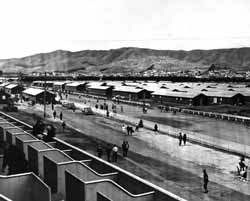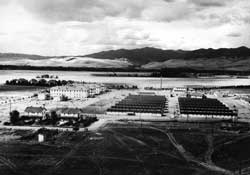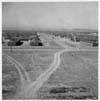Excerpts from a public conversation with Fred Korematsu. He was the U.S. citizen who during World War II refused to comply with U.S. military orders directing his exclusion, because he was of Japanese ancestry, from his native California to an internment camp in the western interior of the United States.
For that refusal, Korematsu was charged and convicted of a federal crime. He appealed to the U.S. Supreme Court, losing in December 1944 a 6-3 decision that upheld the constitutionality of military racial discrimination in the interest of national security. In these excerpts, Korematsu describes:
(1) his path from an internment camp in Topaz, Utah, to work in Salt Lake City and Detroit;
(2) learning from his ACLU attorney Ernest Bessig that the Court had ruled against him;
(3) the condition of his family's California nursery when he finally returned from the "concentration camp";
(4) attorney and professor Peter Irons (who "looked like Jesus") persuading him in the 1980s to reopen his case; (5) public ignorance about the internment of Japanese-Americans and his enthusiasm about talking to students; (6) internment's contemporary relevance as an issue of race; and
(7), in response to a teacher's question, the need for students and all to fight for individual rights.
The questioner was John Q. Barrett, Professor of Law at St. John's University and Elizabeth S. Lenna Fellow at the Robert H. Jackson Center. With Fred Korematsu were his wife Kathryn and documentary filmmaker Eric Paul Fournier. This conversation, sponsored by the Jackson Center, occurred at Chautauqua Institution on September 26, 2002.
Topaz Museum is now open with an inaugural art show.
Japanese American WWII Internment Camp
The internment of Americans of Japanese ancestry during WWII was one of the worst violations of civil rights against citizens in the history of the United States. The government and the US Army, falsely citing “military necessity,” locked up over 110,000 men, women and children in ten remote camps controlled by the War Relocation Administration and four male-only camps controlled by the Justice Department. These Americans were never convicted or even charged with any crime, yet were incarcerated for up to four years in prison camps surrounded by barbed wire and armed guards.
The story of these camps has become better known after President Ronald Reagan signed the Civil Liberties Act of 1988 and President George H.W. Bush issued a formal apology and token monetary compensation to all former internees. However, the events and causes of this tragic page in history must never be forgotten. If we can understand what occurred and why, we can insure that a similar denial of civil rights will never happen to any future generation of Americans.
This website contains information about one of the WRA camps, Topaz, which was located 16 miles northwest of Delta in central Utah, on the lip of the Great Basin. Topaz processed 11,212 people through the camp while it was in operation from September 11, 1942 to October 31, 1945.
The Topaz Museum Board, a non-profit, volunteer organization, owns 634 acres of the Topaz site, which was one square mile. The camp begins at 10000 West 4500 North, outside of Delta, Utah. The Museum Board is now seeking funding to build the Topaz Museum on Delta's Main Street.
List of Detention Camps, Temporary Detention Centers, and Department of Justice Internment Camps
DETENTION CAMPS
Permanent detention camps that held internees from March, 1942 until their closing in 1945 and 1946.
Temporary detention centers were used from late March, 1942 until mid-October, 1942, when internees were moved to the ten more permanent internment prisons. These temporary sites were mainly located on large fairgrounds or race tracks in visible and public locations. It would be impossible for local populace to say that they were unaware of the removal and imprisonment of Japanese Americans. |  |
Fresno, California First inmate arrival May 6, 1942. Last inmate departure October 30, 1942. Peak population 5120.
Manzanar, California First inmate arrival March 21, 1942. Peak population (before June 1, 1942) 9666. Before it was leased from the City of Los Angeles, Manzanar was once ranch and farm land until it reverted to desert conditions. Manzanar was transfered from the WCCA to WRA on June 1, 1942, and converted into a "relocation camp."
Marysville, California First inmate arrival May 8, 1942. Last inmate departure June 29, 1942. Peak population 2451.
Mayer, Arizona First inmate arrival May 7, 1942. Last inmate departure June 2, 1942. Peak population 245. Mayer was a camp abaondoned by the Civilian Conservation Corp.
Merced, California First inmate arrival May 6, 1942. Last inmate departure September 15, 1942. Peak population 4508.
Pinedale, California First inmate arrival May 7, 1942. Last inmate departure July 23, 1942. Peak population 4792. Pinedale was the previous site of a mill.
Pomona, California First inmate arrival May 7, 1942. Last inmate departure August 24, 1942. Peak population 5434.
Portland, Oregon First inmate arrival May 2, 1942. Last inmate departure September 10, 1942. Peak population 3676. Portland used the Pacific International Live Stock Exposition Facilities to hold detainees.
Puyallup, Washington First inmate arrival April 28, 1942. Last inmate departure September 12, 1942. Peak population 7390.5
Sacramento, California First inmate arrival May 6, 1942. Last inmate departure June 26, 1942. Peak population 4739. Sacramento used a former migrant camp.
Salinas, California First inmate arrival April 27, 1942. Last inmate departure July 4, 1942. Peak population 3594.
Santa Anita, California First inmate arrival March 27, 1942. Last inmate departure October 27, 1942. Peak population 18,719.
Stockton, California First inmate arrival May 10, 1942. Last inmate departure October 17, 1942. Peak population 4271.
Tanforan, San Bruno, California First inmate arrival April 28, 1942. Last inmate departure October 13, 1942. Peak population 7816. Tanforan is now a large shopping mall by the same name.
Tulare, California First inmate arrival April 20, 1942. Last inmate departure September 4, 1942. Peak population 4978.
Turlock, Byron, California First inmate arrival April 30, 1942. Last inmate departure August 12, 1942. Peak population 3662.
JUSTICE DEPARTMENT INTERNMENT CAMPS
27 U.S. Department of Justice Camps (most at Crystal City, Texas, but also Seagoville, Texas; Kooskia, Idaho; Santa Fe, NM; and Ft. Missoula, Montana) were used to incarcerate 2,260 "dangerous persons" of Japanese ancestry taken from 12 Latin American countries by the US State and Justice Departments. Approximately 1,800 were Japanese Peruvians.
The U.S. government wanted them as bargaining chips for potential hostage exchanges with Japan, and actually did use. After the war, 1400 were prevented from returning to their former country, Peru.
Over 900 Japanese Peruvians were deported to Japan. 300 fought it in the courts and were allowed to settle in Seabrook, NJ. Efforts to bring justice to the Japanese Peruvians are still active; for information contact Grace Shimizu, 510-528-7288.
| Santa Fe, NM Bismarck, ND Crystal City, TX Missoula, MT Seagoville, Texas Kooskia, Idaho |  Ft. Missoula, Montana Internment Camp Ft. Missoula, Montana Internment Camp |











No comments:
Post a Comment